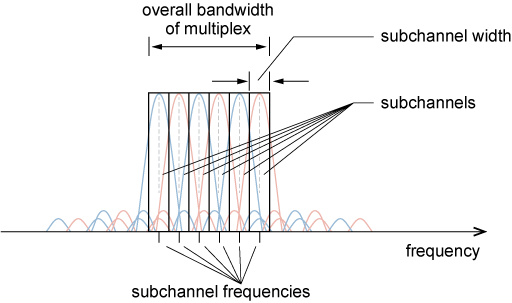4.2 Orthogonal frequency division multiplexing (OFDM)
Orthogonal Frequency Division Multiplexing, (OFDM) and its close relative Orthogonal Frequency Division Multiple Access (OFDMA), are widely used forms of modulation. They are used in DSL broadband, 4G mobile communications, WiFi, digital television, powerline communications, cable television and digital audio broadcasting (DAB).
Modulation always spreads the power of a transmission around the carrier frequency. In conventional frequency division multiplexing (FDM), as used in radio broadcasting for example, carrier frequencies are well separated to prevent the intrusion of power from neighbouring carriers. Figure 4.1 shows power distribution around some modulated carriers.
In OFDM, by contrast, all the carriers (known as subcarriers) are closely packed. As a result, their spectra overlap. The expected mutual interference doesn’t occur because each subcarrier frequency coincides with zero power in all the other subcarriers, as shown in Figure 4.2. The subcarrier spacing required to make this happen is determined by a mathematical relationship between the spacing and the symbol rate of the modulation.
All the subcarriers operate at the same symbol rate, but each is usually modulated independently of the others. We can think of each subcarrier as being at the centre of a narrow frequency channel, as in Figure 4.3. In OFDM, these channels are called subchannels, and their width is equal to the subcarrier spacing.
A good example of the use of subcarriers and subchannels is Digital Subscriber Line broadband, or DSL.



